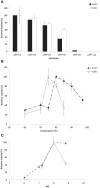Identification of novel esterase-active enzymes from hot environments by use of the host bacterium Thermus thermophilus
- PMID: 25904908
- PMCID: PMC4389547
- DOI: 10.3389/fmicb.2015.00275
Identification of novel esterase-active enzymes from hot environments by use of the host bacterium Thermus thermophilus
Abstract
Functional metagenomic screening strategies, which are independent of known sequence information, can lead to the identification of truly novel genes and enzymes. Since E. coli has been used exhaustively for this purpose as a host, it is important to establish alternative expression hosts and to use them for functional metagenomic screening for new enzymes. In this study we show that Thermus thermophilus HB27 is an excellent screening host and can be used as an alternative provider of truly novel biocatalysts. In a previous study we constructed mutant strain BL03 with multiple markerless deletions in genes for major extra- and intracellular lipolytic activities. This esterase-diminished strain was no longer able to grow on defined minimal medium supplemented with tributyrin as the sole carbon source and could be used as a host to screen for metagenomic DNA fragments that could complement growth on tributyrin. Several thousand single fosmid clones from thermophilic metagenomic libraries from heated compost and hot spring water samples were subjected to a comparative screening for esterase activity in both T. thermophilus strain BL03 and E. coli EPI300. We scored a greater number of active esterase clones in the thermophilic bacterium than in the mesophilic E. coli. From several thousand functionally screened clones only two thermostable α/β-fold hydrolase enzymes with high amino acid sequence similarity to already characterized enzymes were identifiable in E. coli. In contrast, five further fosmids were found that conferred lipolytic activities in T. thermophilus only. Four open reading frames (ORFs) were found which did not share significant similarity to known esterase enzymes but contained the conserved GXSXG motif regularly found in lipolytic enzymes. Two of the genes were expressed in both hosts and the novel thermophilic esterases, which based on their primary structures could not be assigned to known esterase or lipase families, were purified and preliminarily characterized. Our work underscores the benefit of using additional screening hosts other than E. coli for the identification of novel biocatalysts with industrial relevance.
Keywords: Thermus thermophiles; comparative screening; functional metagenomics; novel metagenomic esterases; novel screening host.
Figures




Similar articles
-
Thermus thermophilus as a Source of Thermostable Lipolytic Enzymes.Microorganisms. 2015 Nov 4;3(4):792-808. doi: 10.3390/microorganisms3040792. Microorganisms. 2015. PMID: 27682117 Free PMC article. Review.
-
Genetic analysis of lipolytic activities in Thermus thermophilus HB27.J Biotechnol. 2014 Dec 10;191:150-7. doi: 10.1016/j.jbiotec.2014.07.448. Epub 2014 Aug 4. J Biotechnol. 2014. PMID: 25102235
-
Characterization of a novel thermostable esterase from Thermus scotoductus SA-01: evidence of a new family of lipolytic esterases.Curr Microbiol. 2010 Apr;60(4):248-53. doi: 10.1007/s00284-009-9533-5. Epub 2009 Dec 5. Curr Microbiol. 2010. PMID: 19967376
-
A two-host fosmid system for functional screening of (meta)genomic libraries from extreme thermophiles.Syst Appl Microbiol. 2009 May;32(3):177-85. doi: 10.1016/j.syapm.2008.01.003. Epub 2009 Mar 13. Syst Appl Microbiol. 2009. PMID: 19285378
-
Lipases and esterases from extremophiles: overview and case example of the production and purification of an esterase from Thermus thermophilus HB27.Methods Mol Biol. 2012;861:239-66. doi: 10.1007/978-1-61779-600-5_15. Methods Mol Biol. 2012. PMID: 22426723 Review.
Cited by
-
Bioprospecting for Thermozymes and Characterization of a Novel Lipolytic Thermozyme Belonging to the SGNH/GDSL Family of Hydrolases.Int J Mol Sci. 2022 May 20;23(10):5733. doi: 10.3390/ijms23105733. Int J Mol Sci. 2022. PMID: 35628544 Free PMC article.
-
Thermus thermophilus as a Source of Thermostable Lipolytic Enzymes.Microorganisms. 2015 Nov 4;3(4):792-808. doi: 10.3390/microorganisms3040792. Microorganisms. 2015. PMID: 27682117 Free PMC article. Review.
-
Management of microbial enzymes for biofuels and biogas production by using metagenomic and genome editing approaches.3 Biotech. 2021 Oct;11(10):429. doi: 10.1007/s13205-021-02962-x. Epub 2021 Sep 8. 3 Biotech. 2021. PMID: 34603908 Free PMC article. Review.
-
Metagenomics of an Alkaline Hot Spring in Galicia (Spain): Microbial Diversity Analysis and Screening for Novel Lipolytic Enzymes.Front Microbiol. 2015 Nov 20;6:1291. doi: 10.3389/fmicb.2015.01291. eCollection 2015. Front Microbiol. 2015. PMID: 26635759 Free PMC article.
-
Role of metagenomics in prospecting novel endoglucanases, accentuating functional metagenomics approach in second-generation biofuel production: a review.Biomass Convers Biorefin. 2023;13(2):1371-1398. doi: 10.1007/s13399-020-01186-y. Epub 2021 Jan 7. Biomass Convers Biorefin. 2023. PMID: 33437563 Free PMC article. Review.
References
LinkOut - more resources
Full Text Sources
Other Literature Sources
Molecular Biology Databases

